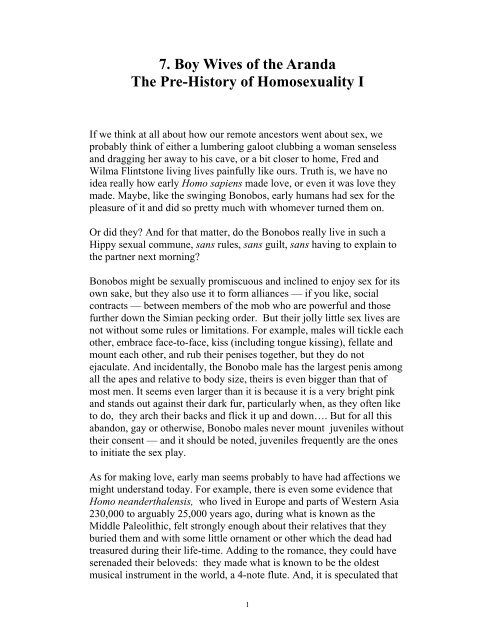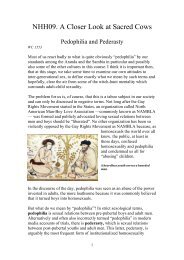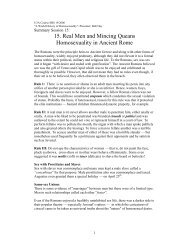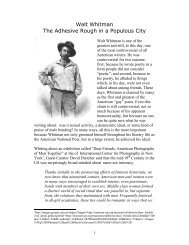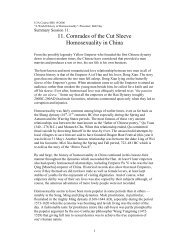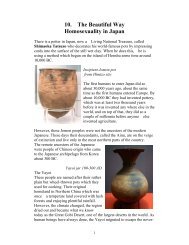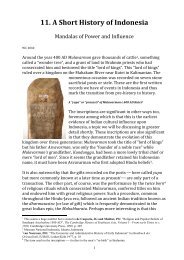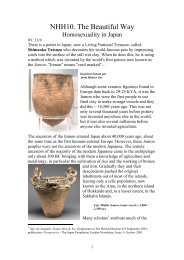7. Boy Wives of the Aranda The Pre-History of ... - BobHay.net
7. Boy Wives of the Aranda The Pre-History of ... - BobHay.net
7. Boy Wives of the Aranda The Pre-History of ... - BobHay.net
Create successful ePaper yourself
Turn your PDF publications into a flip-book with our unique Google optimized e-Paper software.
<strong>7.</strong> <strong>Boy</strong> <strong>Wives</strong> <strong>of</strong> <strong>the</strong> <strong>Aranda</strong><br />
<strong>The</strong> <strong>Pre</strong>-<strong>History</strong> <strong>of</strong> Homosexuality I<br />
If we think at all about how our remote ancestors went about sex, we<br />
probably think <strong>of</strong> ei<strong>the</strong>r a lumbering galoot clubbing a woman senseless<br />
and dragging her away to his cave, or a bit closer to home, Fred and<br />
Wilma Flintstone living lives painfully like ours. Truth is, we have no<br />
idea really how early Homo sapiens made love, or even it was love <strong>the</strong>y<br />
made. Maybe, like <strong>the</strong> swinging Bonobos, early humans had sex for <strong>the</strong><br />
pleasure <strong>of</strong> it and did so pretty much with whomever turned <strong>the</strong>m on.<br />
Or did <strong>the</strong>y? And for that matter, do <strong>the</strong> Bonobos really live in such a<br />
Hippy sexual commune, sans rules, sans guilt, sans having to explain to<br />
<strong>the</strong> partner next morning?<br />
Bonobos might be sexually promiscuous and inclined to enjoy sex for its<br />
own sake, but <strong>the</strong>y also use it to form alliances — if you like, social<br />
contracts — between members <strong>of</strong> <strong>the</strong> mob who are powerful and those<br />
fur<strong>the</strong>r down <strong>the</strong> Simian pecking order. But <strong>the</strong>ir jolly little sex lives are<br />
not without some rules or limitations. For example, males will tickle each<br />
o<strong>the</strong>r, embrace face-to-face, kiss (including tongue kissing), fellate and<br />
mount each o<strong>the</strong>r, and rub <strong>the</strong>ir penises toge<strong>the</strong>r, but <strong>the</strong>y do not<br />
ejaculate. And incidentally, <strong>the</strong> Bonobo male has <strong>the</strong> largest penis among<br />
all <strong>the</strong> apes and relative to body size, <strong>the</strong>irs is even bigger than that <strong>of</strong><br />
most men. It seems even larger than it is because it is a very bright pink<br />
and stands out against <strong>the</strong>ir dark fur, particularly when, as <strong>the</strong>y <strong>of</strong>ten like<br />
to do, <strong>the</strong>y arch <strong>the</strong>ir backs and flick it up and down…. But for all this<br />
abandon, gay or o<strong>the</strong>rwise, Bonobo males never mount juveniles without<br />
<strong>the</strong>ir consent — and it should be noted, juveniles frequently are <strong>the</strong> ones<br />
to initiate <strong>the</strong> sex play.<br />
As for making love, early man seems probably to have had affections we<br />
might understand today. For example, <strong>the</strong>re is even some evidence that<br />
Homo neanderthalensis, who lived in Europe and parts <strong>of</strong> Western Asia<br />
230,000 to arguably 25,000 years ago, during what is known as <strong>the</strong><br />
Middle Paleolithic, felt strongly enough about <strong>the</strong>ir relatives that <strong>the</strong>y<br />
buried <strong>the</strong>m and with some little ornament or o<strong>the</strong>r which <strong>the</strong> dead had<br />
treasured during <strong>the</strong>ir life-time. Adding to <strong>the</strong> romance, <strong>the</strong>y could have<br />
serenaded <strong>the</strong>ir beloveds: <strong>the</strong>y made what is known to be <strong>the</strong> oldest<br />
musical instrument in <strong>the</strong> world, a 4-note flute. And, it is speculated that<br />
1
<strong>the</strong>y had high-pitched voices and some form <strong>of</strong> language so <strong>the</strong>y might<br />
even have been able to sing albeit to our ears, falsetto. It is not known if<br />
Neanderthals and our ancestors, Homo sapiens sapiens, were able to mate<br />
with each o<strong>the</strong>r. Most scientists believe <strong>the</strong>y could not or if <strong>the</strong>y could,<br />
<strong>the</strong> <strong>of</strong>fspring would have been sterile, as mules are today. If by some<br />
chance <strong>the</strong>y were able to mate properly with modern man and pass on<br />
some genes, <strong>the</strong>n <strong>the</strong>re is an argument that we have inherited red hair<br />
from <strong>the</strong>m!<br />
<strong>The</strong> last Neanderthal died sometime between 29,000 and 25,000 years<br />
ago, many scientists suggesting that our ancestors ei<strong>the</strong>r killed <strong>the</strong>m<br />
directly in fights, or indirectly by depriving <strong>the</strong>m <strong>of</strong> living space.<br />
<strong>The</strong> Year Dot 1<br />
It was something like 4 million years ago that some chimpanzee-like<br />
ancestors <strong>of</strong> ours started walking on <strong>the</strong>ir hind legs. <strong>The</strong> upshot <strong>of</strong> this<br />
was that <strong>the</strong> upright stance hid <strong>the</strong> female genitals from view while at <strong>the</strong><br />
same time <strong>the</strong> buttocks grew larger. Breasts developed in females, body<br />
hair started to disappear, especially in females, while what had been, in<br />
earlier species, a very large clitoris grew smaller. Among males, <strong>the</strong><br />
miniscule penis <strong>of</strong> earlier models thankfully grew larger…<br />
While simply standing up hid <strong>the</strong> female genitalia, <strong>the</strong> o<strong>the</strong>r changes are<br />
difficult to explain as a response to some external challenge — for<br />
example, to prolonged drought or o<strong>the</strong>r climate change. Darwin himself<br />
recognized that many <strong>of</strong> <strong>the</strong>se changes in early man made no sense in<br />
terms <strong>of</strong> survival <strong>of</strong> <strong>the</strong> fittest and he postulated “sexual selection”, a<br />
process he argued had as much influence upon evolution as<br />
environmental pressures. This is <strong>the</strong> process <strong>of</strong> mate selection which has<br />
resulted in <strong>the</strong> peacock’s glorious but o<strong>the</strong>rwise useless tail which, in<br />
simple survival terms might even be a liability. However, it turns <strong>the</strong><br />
female on and she selects <strong>the</strong> male she considers to have <strong>the</strong> best tail…..<br />
When females started to walk upright, not only was <strong>the</strong> focus <strong>of</strong> attention<br />
shifted from buttocks and estrous labia to breasts but it also changed <strong>the</strong><br />
shape <strong>of</strong> <strong>the</strong> pelvis and birth canal so that childbirth became more painful<br />
and dangerous. This too does not make sense in terms <strong>of</strong> simple<br />
Darwinian selection but it did make sexual selection more important in<br />
directing <strong>the</strong> development <strong>of</strong> <strong>the</strong> human race. Walking upright freed <strong>the</strong><br />
hands to make and use tools, although <strong>the</strong> tools used by <strong>the</strong> earliest<br />
1 For much <strong>of</strong> this section I am indebted to Timothy Taylor: “<strong>The</strong> <strong>Pre</strong>history <strong>of</strong> Sex:<br />
Four Million Years <strong>of</strong> Human Sexual Culture”, Fourth Estate, London 1996, Pp 4 ff.<br />
2
humans, which were undoubtedly made from grasses and wood and o<strong>the</strong>r<br />
perishable materials, have not survived. It is not until much fur<strong>the</strong>r down<br />
<strong>the</strong> track that we find stone and bone tools which demonstrate <strong>the</strong><br />
different capacities <strong>of</strong> both Neanderthal and our own Stone Age<br />
ancestors. 2<br />
By <strong>the</strong> time our ancestors came out <strong>of</strong> Africa <strong>the</strong>y were physically<br />
indistinguishable from us. <strong>The</strong>re have been many mutations and<br />
variations since <strong>the</strong>n, <strong>of</strong> course, but for those <strong>of</strong> us <strong>of</strong> European ancestry,<br />
we are no different from our remote ancestors who entered Europe 35,000<br />
to 25,000 years ago. This was a reasonably warm period when <strong>the</strong>re was<br />
sufficient game and o<strong>the</strong>r resources to sustain <strong>the</strong>m in <strong>the</strong>ir hunting,<br />
fishing and ga<strong>the</strong>ring lifestyle.<br />
<strong>The</strong> earliest people to enter Europe from <strong>the</strong> east were what is termed<br />
today <strong>the</strong> Aurignacian, a term referring to a fine flint-knapping<br />
technology which <strong>the</strong>y had developed, <strong>the</strong> remains <strong>of</strong> which tell us all we<br />
know about <strong>the</strong>m. When <strong>the</strong>y entered Europe, probably through Bulgaria<br />
and Hungary, <strong>the</strong>y gradually displaced <strong>the</strong> Neanderthals, driving <strong>the</strong> last<br />
<strong>of</strong> <strong>the</strong>m into westernmost Iberia.<br />
It is about this time that we begin to get our first glimpses <strong>of</strong> human<br />
sexuality. Perhaps <strong>the</strong> best-known representation <strong>of</strong> a human figure is <strong>the</strong><br />
so-called Venus <strong>of</strong> Willendorf , a diminutive figurine <strong>of</strong> a very fat<br />
woman, carved in Oolitic limestone anywhere from 30,000 to 18,000<br />
years ago. Now held in <strong>the</strong> Naturhistorisches Museum, Vienna, this little<br />
lady is only 4.4 inches (11.1 cm) tall. However, she raises more<br />
questions than <strong>the</strong> Mona Lisa: for example, why is she so fat? <strong>The</strong><br />
nomadic hunter/fisher/ga<strong>the</strong>rer lifestyle <strong>of</strong> her day would have made it<br />
pretty near impossible for her to grow obese unless <strong>the</strong>re were women<br />
2 Somewhere along <strong>the</strong> evolutionary trail, our ancestors’ brain size started to grow<br />
larger, reaching its present size about 150,000 years ago. Neanderthal actually ended<br />
up with a larger brain than ours although <strong>the</strong>re is no evidence his species was any<br />
smarter. While <strong>the</strong>re seems to have been no environmental reason why our brains<br />
should have enlarged, many scientists suggest that it did so in order to accommodate<br />
<strong>the</strong> growth <strong>of</strong> culture, including language. It might also have been triggered by our<br />
move to upright stance: standing up we could see much more with our binocular<br />
vision. Possibly this too demanded more computing power. However, standing<br />
upright meant that our noses were fur<strong>the</strong>r from <strong>the</strong> ground and so we could not<br />
depend on scent as much as four-legged animals do when hunting. <strong>The</strong>re is a <strong>the</strong>ory<br />
that humans domesticated dogs whose million-fold sense <strong>of</strong> smell compensated us for<br />
our loss <strong>of</strong> smell while our vision far outstripped that <strong>of</strong> our best friends.<br />
3
who were held in such high regard (for example, priestesses or some kind<br />
<strong>of</strong> ruler) who were not only fed <strong>the</strong> best <strong>of</strong> everything but perhaps carried<br />
ra<strong>the</strong>r than walking under <strong>the</strong>ir own steam. As was originally suggested,<br />
maybe she was a goddess? Who knows? But one little piece <strong>of</strong><br />
information has come to light recently: archeologists now believe that<br />
<strong>the</strong> bobbly protrusions on her head are not hair but a head-dress.<br />
Ano<strong>the</strong>r “Venus” figurine, <strong>the</strong> so-called "La Dame à la capuche" or<br />
"Dame de Brassempouy" was discovered in Chalosse in 1894. This is an<br />
ivory head, 3.2 cm (1¼ inches) high and has been dated as "Perigordian".<br />
La Dame is <strong>the</strong> first representation <strong>of</strong> a human face in <strong>the</strong> whole <strong>of</strong><br />
prehistory. <strong>The</strong>se days she lives in <strong>the</strong> National Museum <strong>of</strong> Antiquities in<br />
St Germain en Laye. La Dame, like <strong>the</strong> Venus de Willendorf, also has a<br />
headdress, <strong>the</strong> “capuche”. It has been argued that <strong>the</strong>se headdresses were<br />
woven and <strong>the</strong>refore not only demonstrate that weaving was one <strong>of</strong> <strong>the</strong><br />
skills <strong>the</strong>se ancient people possessed, it also suggests some kind <strong>of</strong> social<br />
organization, perhaps tribal. <strong>The</strong>se little figures also beg <strong>the</strong> question:<br />
“Was fat beautiful in <strong>the</strong> eyes <strong>of</strong> our remote ancestors?” If so, <strong>the</strong>n<br />
interestingly, all <strong>the</strong> representations we have <strong>of</strong> men show <strong>the</strong>m to be<br />
thin.<br />
As for pre-historic homosexuality, <strong>the</strong> only evidence we have from that<br />
pre-Ice-Age time comes from a small valley in Moravia in <strong>the</strong> modern<br />
Czech Republic, now called Dolní Vestonice, near Brno. In that valley a<br />
community <strong>of</strong> perhaps no more than 100 Cro-Magnon people managed<br />
to live what seems to have been a relatively sophisticated life-style for<br />
several thousand years.<br />
In 1986, archeologists discovered three skeletons buried toge<strong>the</strong>r in a<br />
common grave some 28,000 years ago. <strong>The</strong> skeletons were <strong>of</strong> three<br />
people, all young — about 18-20 years old when <strong>the</strong>y died — <strong>the</strong> outer<br />
ones both healthy, robust young men while <strong>the</strong> one in <strong>the</strong> middle had not<br />
been so lucky in his lifetime. Although <strong>the</strong> sex <strong>of</strong> this skeleton was hard<br />
to determine — initially, assumed to be female although some<br />
pathologists considered it to be “inter-sex” — <strong>the</strong> consensus now seems<br />
to be that he was indeed male, but badly deformed by some congenital<br />
disability causing his thigh bone to fuse to his hip and thus making it<br />
difficult for him to walk. He would have been in serious pain in his<br />
lifetime….<br />
All three bodies had been buried after rigor mortis had relaxed, leaving<br />
<strong>the</strong>m pliable enough to be carefully arranged in <strong>the</strong> grave. <strong>The</strong> disabled<br />
young man in <strong>the</strong> center was buried first, <strong>the</strong>n <strong>the</strong> one on <strong>the</strong> right was<br />
4
laid down on top <strong>of</strong> him, face down, with <strong>the</strong>ir arms entwined. For some<br />
reason or o<strong>the</strong>r, this man was looking away from <strong>the</strong> middle youth. He<br />
was also wearing a necklace <strong>of</strong> wolf teeth, evidence that even so long<br />
ago, people adorned <strong>the</strong>mselves although, <strong>of</strong> course, this could have had<br />
some magical intent.<br />
<strong>The</strong> disabled youth in <strong>the</strong> centre was buried looking at <strong>the</strong> one to his<br />
right, <strong>the</strong> man with <strong>the</strong> wolf-teeth necklace; his forehead was covered<br />
with red ochre and he wore a necklace <strong>of</strong> Artic fox teeth. Between his<br />
legs or perhaps in his anus had been placed a red ochre statuette — or<br />
maybe a dildo <strong>of</strong> which many examples have been found in <strong>the</strong> valley.<br />
When <strong>the</strong> young man on <strong>the</strong> left was placed in <strong>the</strong> grave, he was still<br />
alive. He might have been wearing a mask — or, at least, his face had<br />
been painted with red ochre — and he wore a necklace <strong>of</strong> human teeth. A<br />
stake had been driven through his groin and he had been left to die. Later,<br />
his body had been re-arranged so that he appeared to be looking at <strong>the</strong><br />
crotch <strong>of</strong> <strong>the</strong> youth in <strong>the</strong> middle and his hands were reaching out as<br />
though to touch him <strong>the</strong>re.<br />
Although this tableau mort has been interpreted in many ways 3 , an<br />
interesting reading by Connell O’Donovan 4 is that it represents a samesex<br />
relationship gone “horribly wrong”. He suggests that <strong>the</strong> youth in <strong>the</strong><br />
3 Timothy Taylor has several scenarios, but <strong>the</strong>se were written before <strong>the</strong> youth in <strong>the</strong><br />
middle was determined to be male. See Taylor, op. cit., pp 112-113.<br />
4 http://home.earthlink.<strong>net</strong>/~ekerilaz/dolni.html<br />
5
centre 5 and <strong>the</strong> one to his right were lovers while <strong>the</strong> one to <strong>the</strong> left might<br />
have seduced, raped or even castrated <strong>the</strong> middle man (castrated because<br />
<strong>of</strong> <strong>the</strong> red ochre between his legs). He fur<strong>the</strong>r surmises that this so<br />
humiliated <strong>the</strong> middle man that he committed suicide and that his lover<br />
killed himself from grief. <strong>The</strong> community was so incensed that <strong>the</strong>y<br />
executed <strong>the</strong> man on <strong>the</strong> left and after all three were dead, buried <strong>the</strong>m so<br />
that <strong>the</strong>ir story could be read for evermore….<br />
An <strong>Aranda</strong> 6 Interlude<br />
Fat or thin, we tend not to flesh out <strong>the</strong> lives <strong>of</strong> our ancient ancestors but<br />
to consider <strong>the</strong>m almost in <strong>the</strong> abstract, wraiths that wandered <strong>the</strong> interglacial<br />
landscape, spearing mammoths and most importantly, passing on<br />
<strong>the</strong>ir genes to us. To demonstrate that hunter/fisher/ga<strong>the</strong>rers who have<br />
left very few artifacts to posterity and whose level <strong>of</strong> technology was low<br />
by our standards, we need look no fur<strong>the</strong>r than some <strong>of</strong> <strong>the</strong> Australian<br />
aboriginal people whose physical lives were similarly low-tech but who<br />
demonstrably had an immensely rich cultural life.<br />
But first, I must warn that I do not intend to use <strong>the</strong> example <strong>of</strong> <strong>the</strong><br />
<strong>Aranda</strong> to extrapolate to our remote European ancestors back in<br />
hunter/ga<strong>the</strong>r/fisher times before <strong>the</strong> Last Ice Age. You cannot<br />
extrapolate from one culture to ano<strong>the</strong>r because each is its own unique<br />
adaptation to <strong>the</strong>ir particular environment. However, <strong>the</strong> <strong>Aranda</strong> do<br />
admirably demonstrate that societies which are nomadic and have a low<br />
level <strong>of</strong> technology can still be very sophisticated in <strong>the</strong> organisation <strong>of</strong><br />
<strong>the</strong>ir social, psychological and spiritual lives and presumably, in <strong>the</strong><br />
regulation <strong>of</strong> <strong>the</strong>ir sex lives as well.<br />
At <strong>the</strong> time Australia became one nation — 1901 — <strong>the</strong>re were probably<br />
about 2,000 <strong>Aranda</strong> people living in a huge territory in and south <strong>of</strong> <strong>the</strong><br />
Flinders Ranges. <strong>The</strong>y were one <strong>of</strong> <strong>the</strong> largest groups <strong>of</strong> Aboriginals <strong>the</strong>n<br />
in existence. However, by <strong>the</strong> time Old Parliament House finally opened<br />
5 O’Donovan (Ibid). suggests that <strong>the</strong> necklace <strong>of</strong> fox teeth this man was wearing<br />
symbolises his passive homosexuality. He writes: “<strong>the</strong> fox has a long association in<br />
Europe with passive homosexuals because <strong>of</strong> its anthropomorphic wiliness, beguiling<br />
"smile", and liminal character who is nei<strong>the</strong>r fully wild nor fully domesticated.”<br />
6 <strong>The</strong>re are many variations on this name including: A'randa, Aranta, Arunda, Arunta,<br />
Arranda, Arinta etc. <strong>The</strong> “Arunta” form seems to be based on a mis-hearing by <strong>the</strong><br />
early anthropologist, Sir Baldwin Spencer.<br />
6
for business, a matter <strong>of</strong> less than 30 years, <strong>the</strong>ir numbers had fallen to<br />
just 300 or 400. 7<br />
<strong>The</strong> over-all group was divided into five sub-groups 8 : although some<br />
anthropologists thought <strong>the</strong> most Sou<strong>the</strong>rn people were sufficiently<br />
different to form a distinct unit. <strong>The</strong> <strong>Aranda</strong> language is part <strong>of</strong> <strong>the</strong> huge<br />
Pama-Nyungan group which makes up approximately 70% (160 <strong>of</strong> <strong>the</strong><br />
228) indigenous languages <strong>of</strong> Australia.<br />
A useful summary <strong>of</strong> <strong>the</strong> <strong>Aranda</strong> way <strong>of</strong> life is given by Martin J Malone 9<br />
<strong>of</strong> <strong>the</strong> Centre for Social Anthropology and Computing at <strong>the</strong> University<br />
<strong>of</strong> Kent. Much <strong>of</strong> what follows is a synopsis <strong>of</strong> what he wrote.<br />
<strong>The</strong> climate in that part <strong>of</strong> Australia is hot and dry with only two seasons<br />
a year, a long dry and a short wet season. <strong>The</strong> topography varies greatly,<br />
from <strong>the</strong> flatlands in <strong>the</strong> South which are only 20m (70 feet) above sea<br />
level to over 1500m (5,000 feet) on <strong>the</strong> peaks <strong>of</strong> <strong>the</strong> McDonnell Ranges.<br />
<strong>The</strong> driest areas, mostly to <strong>the</strong> south and west, are true desert, although<br />
near <strong>the</strong> Ranges, parts are reasonably well-watered. <strong>The</strong> game available<br />
include kangaroo and emu, wallabies, euros, bandicoots, snakes, frogs<br />
and many species <strong>of</strong> birds. Trees and shrubs in <strong>the</strong> region supplied<br />
timber, gums, herbs and fruits. <strong>The</strong>ir only weapons were spears and<br />
boomerangs. Apparently <strong>the</strong>y had dingoes who helped <strong>the</strong>m hunt but <strong>the</strong>y<br />
were later replaced by dogs which appear to have been kept only for<br />
companionship, not as hunters.<br />
<strong>The</strong> <strong>Aranda</strong>, like all Aboriginal people, were nomadic, constantly moving<br />
from place to place where <strong>the</strong>y knew <strong>the</strong>y could find food. Usually camps<br />
were temporary, little more than a brush shelter, and essentially near a<br />
water-hole. <strong>The</strong>se more-or-less circular lean-tos were occupied by a man<br />
and his wife or wives, children and <strong>of</strong>ten a large number <strong>of</strong> dogs, but <strong>the</strong>y<br />
were used only as to provide shade or some protection against rain. In<br />
warmer wea<strong>the</strong>r, <strong>the</strong> whole family slept outside. People stayed in <strong>the</strong> one<br />
region while <strong>the</strong> food supplies lasted; <strong>the</strong>n <strong>the</strong>y walked to ano<strong>the</strong>r camp<br />
site, but always moving within a circumscribed ancestral territory.<br />
7 Spencer and Gillen 1927<br />
8 E. Strehlow , also Elkin 1938. For distinct group see Tindale 1974: 137, 221<br />
9 Martin J. Malone at http://lucy.ukc.ac.uk/EthnoAtlas/Hmar/Cult_dir/Culture.7827<br />
7
Much <strong>of</strong> <strong>the</strong> year, <strong>the</strong> people hunted and travelled in small groups,<br />
sometimes just family, o<strong>the</strong>r times maybe two or three families<br />
combining, depending on <strong>the</strong> carrying capacity <strong>of</strong> <strong>the</strong> area. Generally<br />
speaking, <strong>the</strong>se local bands — or “hordes” as <strong>the</strong>y are sometimes called<br />
by anthropologists, “mob” by aboriginals speaking English — would not<br />
contain more than 40 people plus <strong>the</strong>ir dogs. <strong>The</strong>ir allotted territory was<br />
usually no more than about 100 square miles.<br />
<strong>The</strong>re was also a more permanently located central camp where once a<br />
year or so <strong>the</strong> whole “tribe” would ga<strong>the</strong>r toge<strong>the</strong>r and conduct important<br />
ceremonies. This larger camp was always set out on <strong>the</strong> ground to reflect<br />
<strong>the</strong> social organisation <strong>of</strong> <strong>the</strong> tribe. Most aboriginal societies were divided<br />
into 4 moieties which in turn were <strong>the</strong>n sub-divided into two subsections.<br />
<strong>The</strong>se divisions were basic to <strong>the</strong> marriage and kinship system <strong>of</strong> <strong>the</strong><br />
tribe. Marriage and even casual sex partners had always to be selected<br />
from <strong>the</strong> appropriate moiety and sub-section because sex with anyone<br />
else was <strong>the</strong>oretically punishable by death. Descent among <strong>the</strong> <strong>Aranda</strong><br />
was patrilineal (that is, through <strong>the</strong> fa<strong>the</strong>r), children taking on <strong>the</strong> moiety<br />
<strong>of</strong> <strong>the</strong>ir fa<strong>the</strong>r but always <strong>of</strong> <strong>the</strong> o<strong>the</strong>r sub-section <strong>of</strong> it. After marriage,<br />
wives went to live with <strong>the</strong>ir husband’s family band, perhaps only<br />
meeting up with <strong>the</strong>ir own biological family during <strong>the</strong> annual ceremonial<br />
get-toge<strong>the</strong>r.<br />
A fur<strong>the</strong>r division within a tribe was <strong>the</strong> “totem”, a system which<br />
associated <strong>the</strong> individual with a special plant or animal. <strong>The</strong>se were only<br />
partially hereditary, partially chosen as <strong>the</strong> result <strong>of</strong> a “dreaming”. <strong>The</strong><br />
<strong>Aranda</strong> believed <strong>the</strong>se totems were <strong>the</strong> souls <strong>of</strong> Dreamtime or Creation<br />
heroes which floated through <strong>the</strong> air and impregnated women, so leading<br />
to a form <strong>of</strong> reincarnation or spiritual recycling. By and large, <strong>the</strong> <strong>Aranda</strong><br />
were not aware <strong>of</strong> <strong>the</strong> role <strong>of</strong> paternity, at least among human beings.<br />
<strong>The</strong> <strong>Aranda</strong> bands had leaders although most were more or less primus<br />
inter pares — first among equals — some <strong>of</strong> whom were men whom my<br />
old pr<strong>of</strong>essor, AP Elkin, called “men <strong>of</strong> high degree”. <strong>The</strong>se were<br />
medicine men and spirit mediums, but <strong>the</strong>ir positions were based on<br />
learning and ability, not on family descent. Elkin called <strong>the</strong>m “men <strong>of</strong><br />
high degree” because he argued <strong>the</strong>y occupied positions in <strong>the</strong> tribe<br />
comparable to pr<strong>of</strong>essors in our own society.<br />
Homosexuality among <strong>the</strong> <strong>Aranda</strong><br />
Unfortunately, because some <strong>of</strong> <strong>the</strong> earliest field workers were squeamish<br />
about intimate sexual matters, particularly homosexual activities, we have<br />
been told that <strong>the</strong>y “knew what went on” but that it was “unfit for<br />
8
publication”. For example, <strong>the</strong>re are several references to homosexuality<br />
among <strong>the</strong> <strong>Aranda</strong> which, it was said was “universal and life-long”.<br />
However it has been difficult to piece toge<strong>the</strong>r exactly what was meant by<br />
this admission.<br />
As far as I can see (and extrapolating from o<strong>the</strong>r tribal areas known to be<br />
similar), sex and sex play was pretty much ubiquitous. Infants and young<br />
children played sex games, particularly what we call “mo<strong>the</strong>rs and<br />
fa<strong>the</strong>rs” or “house”, with a degree <strong>of</strong> accuracy which would horrify most<br />
Western mo<strong>the</strong>rs even in today’s more liberal climate. For example, not<br />
only did little boys and girls build <strong>the</strong>ir own play wind-breaks and light<br />
fires over which <strong>the</strong>y pretended to cook food, but <strong>the</strong>y also actively<br />
rehearsed <strong>the</strong> sexual acts <strong>the</strong>y saw <strong>the</strong>ir parents and o<strong>the</strong>r adults perform<br />
around <strong>the</strong> camp fires or in <strong>the</strong> brush shelters every night. Little girls also<br />
frequently played such games toge<strong>the</strong>r, one pretending to be <strong>the</strong> “fa<strong>the</strong>r”,<br />
lying on top <strong>of</strong> <strong>the</strong> o<strong>the</strong>r and using thrusting hip motions. Often too, <strong>the</strong><br />
“fa<strong>the</strong>r” would end up poking a stick into <strong>the</strong> “mo<strong>the</strong>r’s” vagina, adding<br />
realism by wrapping fibres around <strong>the</strong> end <strong>of</strong> it to emulate <strong>the</strong> glans<br />
penis. Adults, witnessing such displays, ra<strong>the</strong>r than being horrified as me<br />
might be, indulgently applauded <strong>the</strong>ir sexual precocity, provided — and<br />
this was important — that <strong>the</strong> proper kinship relations, such as bro<strong>the</strong>rsister<br />
incest taboos were observed.<br />
Some anthropologists also say this kind <strong>of</strong> sex-play with <strong>the</strong> little penisstick<br />
was carried on by adult women as a form <strong>of</strong> lesbian sex among <strong>the</strong><br />
eastern and western <strong>Aranda</strong>, o<strong>the</strong>r tribes to <strong>the</strong>ir west and north, including<br />
<strong>the</strong> Warramunga to <strong>the</strong> north <strong>of</strong> <strong>the</strong> McDonnel Ranges 10 .<br />
Young boys too played “mo<strong>the</strong>rs and fa<strong>the</strong>rs” with each o<strong>the</strong>r although it<br />
might not have been heterosexual intercourse <strong>the</strong>y were mimicking. A<br />
younger boy would take <strong>the</strong> passive role, allowing an older boy to insert<br />
his penis between his thighs and perform intercrural or interfemoral<br />
intercourse (“frottage”).<br />
More clearly homosexual is <strong>the</strong> practice known as “boy brides”.<br />
Heterosexually, even though <strong>the</strong> classificatory kinship system creates a<br />
range <strong>of</strong> potential mates, girls are usually promised to a specified older<br />
10 Gays and Lesbian Aboriginal alliance: “Peopling <strong>the</strong> Empty Mirrror: <strong>the</strong> Prospects<br />
for Lesbian and Gay aboriginal <strong>History</strong>,” in Aldrich, R: Gay Perspectives II – More<br />
Essays in Australian Gay Culture, Department <strong>of</strong> Economic <strong>History</strong> and <strong>the</strong><br />
Australian Centre for Gay and Lesbian Research, University <strong>of</strong> Sydney, 1993, pp 39-<br />
40<br />
9
man when <strong>the</strong>y are still infants or even before birth. When <strong>the</strong>y are still<br />
young children <strong>the</strong>y will be sent to live with <strong>the</strong> man. <strong>The</strong>y might well<br />
sleep toge<strong>the</strong>r and be relatively intimate but coitus does not take place<br />
until <strong>the</strong> girl reaches an appropriate age, usually when <strong>the</strong> first signs <strong>of</strong><br />
puberty appear.<br />
However, boys are also <strong>of</strong>ten given to older men with whom <strong>the</strong>y serve as<br />
intimate servants until <strong>the</strong>y reach <strong>the</strong> age <strong>of</strong> initiation. This so-called<br />
“boy bride” relationship only ever occurs between an uninitiated male,<br />
usually younger than about 14 or so, and an adult man — which means a<br />
male who has passed through <strong>the</strong> initiations ceremonies and has been<br />
subincised. Sub-incision was practised in only some parts <strong>of</strong> Aboriginal<br />
Australia, mostly in <strong>the</strong> Centre and in <strong>the</strong> north to north-western regions..<br />
Some tribes practised circumcision, some subincision; a few practised<br />
both. While circumcision meant <strong>the</strong> removal <strong>of</strong> a small section <strong>of</strong> <strong>the</strong><br />
prepuce, subincision involved making a slit into <strong>the</strong> urethra on <strong>the</strong> underside<br />
<strong>of</strong> <strong>the</strong> penis. Over a man’s lifetime repeated cutting like this for ritual<br />
purposes (<strong>the</strong> blood was used to glue fea<strong>the</strong>rs to <strong>the</strong> body for important<br />
ceremonies) resulted in <strong>the</strong> penis opening out into a kind <strong>of</strong> erectable flap<br />
ra<strong>the</strong>r than <strong>the</strong> usual tubular shape. Some anthropologists argues this was<br />
to serve as a contraceptive measure — ejaculation would be from <strong>the</strong> base<br />
<strong>of</strong> <strong>the</strong> penis, not from <strong>the</strong> meatus — but Ashley Montague 11 argues that<br />
this would not have been effective because <strong>the</strong> ejaculation was made with<br />
such force that enough would have entered <strong>the</strong> vagina and that, in any<br />
case, <strong>the</strong> <strong>Aranda</strong> did not understand <strong>the</strong> connection between semen and<br />
paternity. He concluded that <strong>the</strong> main reason for subincision was <strong>the</strong><br />
obtain “male menstrual blood” for ceremonial purposes.<br />
Sexually, <strong>the</strong> boy-bride relationship usually took <strong>the</strong> form <strong>of</strong><br />
masturbation, <strong>the</strong> boy getting an erection which he <strong>the</strong>n placed in <strong>the</strong> slit<br />
made by <strong>the</strong> adult man’s subincision; he <strong>the</strong>n closed his hand around both<br />
penises and masturbated <strong>the</strong>m until one or both (assuming <strong>the</strong> boy is old<br />
enough) ejaculated. But this was not just a sexual relationship: <strong>the</strong> boy<br />
slept and ate his meals with his mentor and went hunting with him, so this<br />
was in effect a master/apprentice relationship.<br />
11 <strong>The</strong> reference here escapes me: I know it was in an early issue <strong>of</strong> <strong>the</strong> journal<br />
“Oceania” published by <strong>the</strong> University <strong>of</strong> Sydney and probably dated in <strong>the</strong> 1930s<br />
which was when Ashley-Montague was in Australia.<br />
10
It was not only <strong>the</strong> <strong>Aranda</strong> who had “boy wives”. Ma<strong>the</strong>ws 12 in a footnote<br />
to his 1907 study <strong>of</strong> <strong>the</strong> <strong>Aranda</strong> wrote:<br />
" ………Mr. E. T. Hardman, during his travels in <strong>the</strong><br />
Kimberley district <strong>of</strong> Western Australia in 1883-4, observed<br />
<strong>the</strong> custom <strong>of</strong> single men being presented with what he calls<br />
"a boy wife". He says: "<strong>The</strong>re is no doubt <strong>the</strong>y have<br />
connexion, but <strong>the</strong> natives repudiate with horror and disgust<br />
<strong>the</strong> idea <strong>of</strong> sodomy".<br />
At puberty, boys were separated from <strong>the</strong> women and for <strong>the</strong> next three or<br />
four years, <strong>the</strong>y underwent a series <strong>of</strong> ceremonies as part <strong>of</strong> <strong>the</strong>ir<br />
initiation into adult manhood. As well as circumcision and subincision,<br />
mong <strong>the</strong> <strong>Aranda</strong> this usually involved an ordeal by fire, ano<strong>the</strong>r fairly<br />
common ritual practice in that part <strong>of</strong> Australia.<br />
During initiation, <strong>the</strong> neophytes are subjected to harsh discipline, <strong>of</strong>ten to<br />
very restrictive food taboos, and to seclusion from <strong>the</strong> daily life <strong>of</strong> <strong>the</strong>ir<br />
community. During this time too <strong>the</strong>y were allowed to witness some<br />
ceremonies appropriate to <strong>the</strong> level <strong>of</strong> initiation, to take part in some<br />
ritual acts, to visit <strong>the</strong> sacred tjurungas, and frequenly, to see <strong>the</strong> bullroarers<br />
in action. <strong>Pre</strong>viously <strong>the</strong>y would have only heard <strong>the</strong>se and been<br />
told <strong>the</strong>y were <strong>the</strong> voice <strong>of</strong> a terrible monster <strong>of</strong> which women and<br />
children had every need to be afraid.<br />
Men — and women too —did not stop after just one initiation but<br />
throughout <strong>the</strong>ir lives progressed to higher and higher degrees. Magical<br />
powers were <strong>of</strong>ten ascribed to those who had reached <strong>the</strong> highest levels,<br />
including <strong>the</strong> interesting assertion that <strong>the</strong>y could communicate over vast<br />
distances by mental telepathy. And <strong>of</strong> course, at some stage men ceased<br />
to be <strong>the</strong> one being initiated and became <strong>the</strong> initiators.<br />
Homosexuality elsewhere in Australia<br />
Because so much <strong>of</strong> <strong>the</strong> ritual life <strong>of</strong> aboriginal people was secret, it is<br />
difficult to get detailed information about any homosexual practice during<br />
initiation ceremonies and o<strong>the</strong>r events. One thing is very clear, however,<br />
and that is that whatever sexual connections occurred, ei<strong>the</strong>r homosexual<br />
or heterosexual, had to be within <strong>the</strong> boundaries set by <strong>the</strong> complex<br />
moiety and totem systems. So, for example, within <strong>the</strong> kinship system <strong>of</strong><br />
12 Ma<strong>the</strong>ws, R. H: Notes on <strong>the</strong> <strong>Aranda</strong> Tribe, J Proc Royal Soc New South Wales .<br />
(1907) 41:146-63<br />
11
<strong>the</strong> <strong>Aranda</strong>, <strong>the</strong> “boy-brides” and <strong>the</strong>ir “husbands” were usually classified<br />
as “bro<strong>the</strong>r-in-law “ and so potentially husbands to each o<strong>the</strong>r’s sisters.<br />
However, <strong>the</strong>re are also suggestions in <strong>the</strong> anthropological literature<br />
which indicate that youths and young men who were not yet married —<br />
and in fact, sometimes older men too — engaged in a whole range <strong>of</strong><br />
sexual activities toge<strong>the</strong>r on a more or less casual basis and that this was<br />
exempt from <strong>the</strong> kinship restrictions. It could be that <strong>the</strong> anthropologists<br />
were simply not aware <strong>of</strong> <strong>the</strong> kin relations among such men, but it also<br />
suggests that attitudes towards sex between men were generally fairly<br />
matter-<strong>of</strong>-fact among tribes <strong>of</strong> <strong>the</strong> subincision area and that <strong>the</strong> kinship<br />
restrictions came into play only when a more institutionalized form <strong>of</strong><br />
relationship, characterized by <strong>the</strong> term “boy-bride”, came into effect.<br />
Aboriginal cultures in Australia are generally divided into two<br />
characteristic kinds, <strong>the</strong> “Murrayian” (which extends west <strong>of</strong> a line drawn<br />
roughly north-east to south west through <strong>the</strong> continent) and <strong>the</strong> Koorie,<br />
who occupied <strong>the</strong> area we live in, in <strong>the</strong> South-East. <strong>The</strong> <strong>Aranda</strong> and<br />
o<strong>the</strong>rs discussed so far were all Murrayian cultures. Although <strong>the</strong> <strong>Aranda</strong><br />
were reported to be horrified at <strong>the</strong> thought <strong>of</strong> anal intercourse with a boy<br />
bride, <strong>the</strong>re are suggestions in <strong>the</strong> literature that both oral and anal<br />
insemination were practiced by various Murrayian tribes. However,<br />
because initiation rites were always secret, and because even those<br />
anthropologists who were privileged to witness such events were<br />
unwilling to speak about what went on, we know little about such<br />
matters.<br />
Homosexuality in <strong>the</strong> South East <strong>of</strong> Australia<br />
Perhaps because <strong>the</strong> Aboriginal tribes <strong>of</strong> <strong>the</strong> SouthEast had been in<br />
contact with Europeans for much longer, it has been much harder to find<br />
information about homosexuality among <strong>the</strong> Koories.<br />
However, in his 1904 classic study Native Tribes <strong>of</strong> South-East Australia<br />
, AW Howitt 13 gives a detailed eye-witness account <strong>of</strong> a Kuringal or<br />
initiation ceremony conducted by <strong>the</strong> Yuin men from <strong>the</strong> Manero,<br />
Shoalhaven and Braidwood districts. He recorded that after <strong>the</strong> three boys<br />
were “made men”, culminating in <strong>the</strong> knocking out <strong>of</strong> a front tooth, a<br />
night-long series <strong>of</strong> pantomimes was enacted by <strong>the</strong> initiated men for <strong>the</strong><br />
moral education <strong>of</strong> <strong>the</strong> novitiates.<br />
13 Howitt, A.W. : Native Tribes <strong>of</strong> South-East Australia, Aboriginal Studies <strong>Pre</strong>ss,<br />
Canberra 1996. See “Initiation Ceremonies, Eastern Type”, p.549<br />
12
After depicting <strong>the</strong> rape <strong>of</strong> a sleeping woman and having been told <strong>the</strong><br />
penalty was death, ano<strong>the</strong>r pantomime was carried out which was “still<br />
more striking”. Howitt described it thus:<br />
By itself it seemed to be merely beastliness <strong>of</strong> behaviour. <strong>The</strong><br />
pantomimic actions and words left no doubt that this represented<br />
<strong>the</strong> <strong>of</strong>fences for which, it is said, <strong>the</strong> cities <strong>of</strong> <strong>the</strong> plains were<br />
destroyed by celestial fire.<br />
<strong>The</strong> novitiates were <strong>the</strong>n told, most forcibly, that if <strong>the</strong>y did anything like<br />
that <strong>the</strong>y would be killed.<br />
I don’t know how typical this might have been <strong>of</strong> traditional Koori<br />
cultures <strong>of</strong> <strong>the</strong> South-East or, for that matter, if <strong>the</strong> prohibition against<br />
anal sex also extended to o<strong>the</strong>r forms <strong>of</strong> homosexual activity. Certainly,<br />
homosexuality is as common among contemporary Koori men as it is in<br />
<strong>the</strong> general Australian population.<br />
__________________________________________________________________<br />
13


